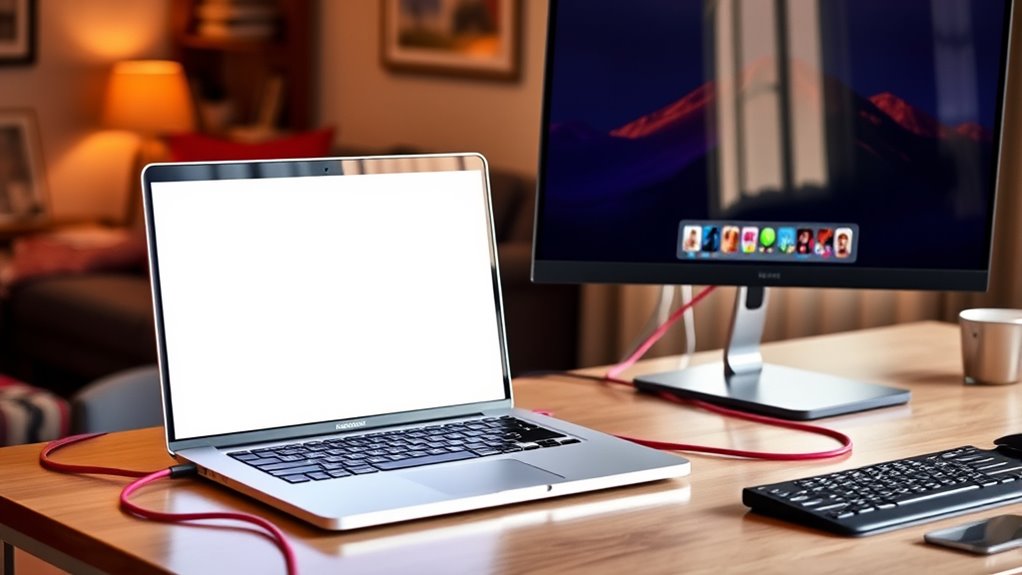To connect your Mac to a monitor, first check the compatible cable types, such as HDMI or USB-C. Plug one end into your Mac and the other into the monitor. Adjust display settings in System Preferences for ideal resolution and organize multiple screens for seamless use. If issues arise, check your connections and restart devices. With these basics covered, you can customize your setup for the best viewing experience and learn more about enhancing your display.
Checking Compatibility and Requirements
Before you connect your Mac to an external monitor, it’s essential to check compatibility and requirements. Start by verifying the display resolution supported by your Mac; this guarantees you get the best visual experience. Look up your Mac’s specifications to see the maximum resolution it can handle. Next, consider the cable types available for your Mac and monitor. Common options include HDMI, DisplayPort, and USB-C, each with varying capabilities. Make certain you have the appropriate cable for seamless connectivity. If your monitor requires an adapter, check its compatibility with your Mac. By confirming these details beforehand, you’ll set the stage for a smooth, hassle-free connection, allowing you to enjoy your larger display without any interruptions.
Connecting Your Mac to the Monitor
Connecting your Mac to an external monitor is a straightforward process that can greatly enhance your productivity. First, identify the cable types your Mac and the monitor support. Common connections include HDMI, DisplayPort, and USB-C. If your Mac’s ports don’t match your monitor, don’t worry; you can use display adapters to bridge the gap. For instance, if you have a Mini DisplayPort on your Mac and HDMI on your monitor, an adapter can help. Simply connect one end of the cable to your Mac and the other to the monitor. Once connected, you’re ready to access the potential of a larger screen, allowing you to multitask effortlessly and enjoy a more immersive viewing experience.
Configuring Display Settings
Once your Mac is connected to the monitor, you’ll want to configure the display settings to optimize your experience. Here are a few key adjustments you can make:
- Set the display resolution: Go to System Preferences > Displays and choose the resolution that best suits your needs. A higher resolution gives you more screen space but may affect performance.
- Color calibration: Access the Color tab in the Displays section to calibrate the color settings. This guarantees accurate colors for your work.
- Arrangement settings: If using multiple monitors, adjust their arrangement for seamless navigation between screens.
Taking these steps will enhance your visual experience, making your workflow more efficient and enjoyable!
Troubleshooting Common Issues
Even if you’ve followed all the steps to connect your Mac to a monitor, issues can still arise. First, check your cable connections; a loose or damaged cable can cause display problems. Verify that the cable is securely plugged into both your Mac and the monitor. If the monitor remains blank, try a different cable or port to rule out a faulty connection.
Next, verify the display resolution settings. Sometimes, your Mac might not automatically adjust to the best resolution for the external monitor. Go to System Preferences, then Displays, and select “Default for Display” or adjust manually.
Lastly, restarting both the Mac and the monitor can often resolve temporary glitches. Don’t hesitate to experiment until everything works smoothly!
Tips for an Enhanced Viewing Experience
To enhance your viewing experience when using an external monitor with your Mac, consider adjusting a few key settings. Taking the time to tweak these can make a significant difference. Here are some tips:
- Display Calibration: Regularly calibrate your monitor to guarantee colors are accurate and true to life.
- Color Settings: Adjust brightness, contrast, and saturation to match your preference for comfortable viewing.
- Resolution and Scaling: Optimize your resolution and scaling settings to achieve crisp text and images without straining your eyes.
Frequently Asked Questions
Can I Use Multiple Monitors With My Mac?
Yes, you can use multiple monitors with your Mac. In fact, 70% of professionals report increased productivity with dual display setups. Just verify your monitors have the right compatibility, and you’re all set for enhanced multitasking!
What Cables Do I Need for Different Monitor Types?
You’ll need HDMI cables for modern displays, while DisplayPort cables offer advanced features. For USB-C compatibility, use appropriate adapters, but remember VGA’s limitations with resolution and quality. Choose wisely for the best experience!
How Do I Switch Between Multiple Displays?
“Two heads are better than one.” To switch between displays, adjust your display arrangement in System Preferences. Use keyboard shortcuts like Command + F1 to toggle between them, giving you the freedom to multitask effortlessly.
Is There a Limit to Monitor Resolution on My Mac?
Yes, there’s a limit to your Mac’s resolution capabilities, which depends on the model and display settings. Check your system preferences to see the maximum resolution supported for your specific Mac and connected monitors.
Can I Mirror My Mac Display to a TV?
Yes, you can mirror your Mac display to a TV! Just use an HDMI connection for a direct link or explore AirPlay streaming for a wireless escape, letting your content dance across the larger screen.

